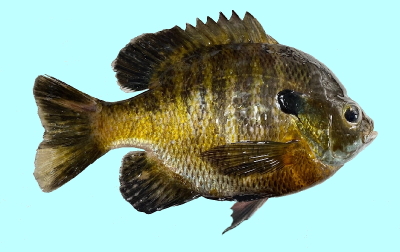
Bluegill Fish Identification, its habitats, characteristics, fishing methods.
Bluegills are one of the most common game fish. They are pond and small lake fish, but also they abundant in natural lakes, large border rivers, and reservoirs. They are quite easily caught, take great varieties of baits and, for their size, provide an excellent fight and a tasty meal. One reason they are so popular is their accessibility to shore anglers and the ability to be caught in great numbers. Bluegills can be caught at any time of year, though, as with many fish, the spawning months are best. In fact, bluegills can be caught quite easily because they are attracted to a wide variety of baits and lures, not easily spooked and they always hungry. Bluegill can live in brackish waters. Most will run from 6 to 8 inches long as adults and weigh 1/4 to 1/2 pound, it can grows to a maximum overall length of approximately 40cm (16 in).
A combination of understanding the fish and the techniques used to catch them will help you to hook more fish to the end of your line. Better knowing and understanding of the fish that you are trying to catch will make you a more successful angler, whether you are fishing for trout on a river or surfing on the beach or trolling on the open water.
Description
The Bluegill has a greatly compressed, oval or rounded (in profile) body that is typical of the sunfishes and a close relative to the Largemouth Bass. Its color is highly variable and many range from olive, dark blue or bluish-purple to yellow, and green on the sides with a blue background. In some cases (notably in quarry holes) it may even appear to be clear or colorless. Usually, there are 6-8 vertical bars on the sides, which may or may not be prominent, depending on the sex of the fish and the time of year. The gill cover (operculum) peaks into a broad, roundish wide black flap and it is not surrounded by a lighter colored trim as it is in some other sunfishes. They have small mouth and head that are typical of sunfish species. The pectoral fins are pointed. The bluegill's most notable feature is the blue or black "ear" (streaks), actually an extension of the gill cover called the opercular flap. Streaks are located on the lower cheeks between the chin and gill cover. This is where the bluegill gets its name. Bellies are almost always a deep yellow or orange in color. Colors become more prominent in breeding males and bright blue and orange are widespread, along with black pelvic fins. Females and young bluegill are less brightly colored.
Habitat and Habits
The Bluegill is a pond and small lake fish; they are also abundant in natural lakes, large border rivers, and reservoirs. Bluegills are closely related to Largemouth Bass, and as you might expect, anywhere there are bass there is an excellent chance bluegills will be present. Large river bluegill spends their summer in deeper water and congregates along undercut banks often favoring old, fallen trees. High water in spring-time and currents scour holes near the bank, often exposing a tangle of roots and other snags. Bluegill living in lakes, reservoirs, and ponds also move to deeper water during the hot days of summer. They can be found along the edges of weeds or in deep coves. They are quite easily caught, take great varieties of baits, are not particularly wary, are forgiving of a less than perfect fishing technique, fight very well for their size are exceptionally fine eating, and are extremely abundant in many ponds and lakes. Bluegill move into deeper water to spend the cold months when autumn turns to winter and water cools.
They prefer environments with warm water and plenty of vegetation and will spend a great deal of time in shallow areas. Their ideal temperature range is between 65 and 72 F but bluegills can tolerate temperature levels much higher or lower. Many bluegills are caught through the ice, as well as during the hottest days of summer.
Bluegills prefer calm, protected waters and will be found most frequently in shallow, weedy environments that harbor adequate numbers of insects and small minnows. In flowing water, they will seek slow-moving streams and rivers, especially around pools. The habitat preferences for bluegill are generally the same as that for the
Largemouth Bass, and anywhere you find largemouth bass, bluegills will likely be nearby.
Young bluegills will focus on insects, worms, and crustaceans almost exclusively in shallow water. Adult bluegill will feed at various depths depending upon water temperature and food availability. Their principal food source is slow-moving aquatic insects, small crayfish, fish eggs, minnows, snails, and worms. They seek food on both the bottom and the surface of the water. During the hottest periods of the year, they often reside in deeper water and then come shallow to feed at sunrise and sunset.
Bluegill spawn in spring when water temperatures reach about 70 F., peaks in May or June, and continues until the water cools again in the fall. In areas that are free from overcrowding, some will spawn again during the latter part of the season. Because of this long spawning season and multi-spawn ability, bluegills have outstanding reproductive potential.
Males create nests in gravel or hard bottoms found in water about 1 to 3 feet deep. Several bluegills will gather in a small area, often creating a spawning “colony” with 50 or more nests. In clear water, this area may appear as a congregation of white spots on the bottom. Males will make the first spawning movements to build the nests. When ready, females will move onto the nests and deposit 40,000 or more eggs. After fertilizing the eggs, males will then protect the nest until the eggs hatch.
After hatching, young bluegill fry will first feed on plankton before their diet shifts to insects and larvae. Eventually, fry will move away from the spawning grounds and travel in small schools until they reach maturity.
Fishing Methods includes: pole fishing, bait casting, fly-fishing, jig fishing, still fishing using bait fish, minnows or killifish, Jigs and nightcrawlers. Fly fishing for bluegills has become increasingly popular and light tackle anglers have long found it to be one of the best action fish that can be caught. Bluegills are popular game fish, caught with live bait, flies, hot dogs, raw chicken, corn, small spoons, small crankbaits, spinners, maggets, they mostly bite on vibrant colors like (orange, yellow, red) chiefly at dawn and dusk. Some of the easiest baits to use for them are earthworms, white bread, or a corn kernel. Efficient bait would be red worms or wax worms on ice jigs. They are noted for seeking out underwater vegetation for cover; their natural diet consists largely of small invertebrates and very small fish. Pole Fishing became very successful for bluegills. It allows us to fish of the far side hiding places, to place your bait exactly where you want it, as quietly as possible, to get it in to the hard to reach places where reel rod can't.
Males can be easy to catch during spawning season because of their protective nature and location of their nests in shallow water. During this season, finding bluegill can be fairly simple. In rivers this will mean finding stumps nestled in a shallow area with a sandy or gravel bottom away from the main current. In lakes, reservoirs and ponds, they will be found in shallow bays, coves and other protected areas near the shoreline.
In summer, lake bluegill will move to deeper water, usually 10 to 20 feet. They also seek out areas of weeds in deep coves. In fall, they will move back toward shallow water, usually near their spawning area. Then, in winter, they will again move back to deeper water.
Most anglers prefer light line and tackle when fishing for bluegill. Because of their propensity to not chase food, it is important to fish slowly. In addition, because of their small mouths, it is preferable to use a small hook. Once one bluegill is caught, the chances for catching more are high because they tend to travel and locate in schools.
Many types of bait and lures will attract bluegills. Nightcrawlers, grasshoppers, crickets, and maggots are highly effective, and small leadhead jigs tipped with tiny bodies will also work well. Bluegills are also a favored species for the fly angler. They will readily strike dry flies and small popping bugs on the surface.


































